Llano in the Wild: Toshiba's Satellite L775D-S7206
by Dustin Sklavos on August 12, 2011 12:45 AM ESTSeventeen Inches of Mediocrity
The more notebooks I review, the more I find that the bog standard resolutions available for many of these form factors just aren't enough. 1366x768 in a 15.6" notebook borders on offensive, but 1600x900 at 17.3" really isn't a walk in the park either. The overall resolution is an improvement from the 1440x900 that old 17" notebooks used to run at, but dot pitch is still high. It seems like if you want a good screen, you need to find a notebook that supports 1080p.
Toshiba's Satellite L775D-S7206 sports a middling 17.3", LED-backlit 1600x900 screen that's serviceable but as you'll see, utterly unexciting. This is to be expected given the price tag and resulting market the notebook is aimed at.
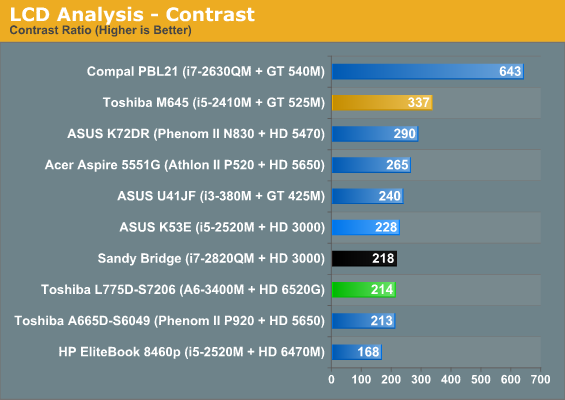
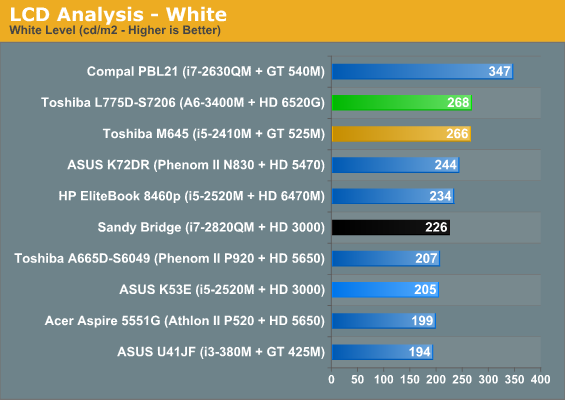

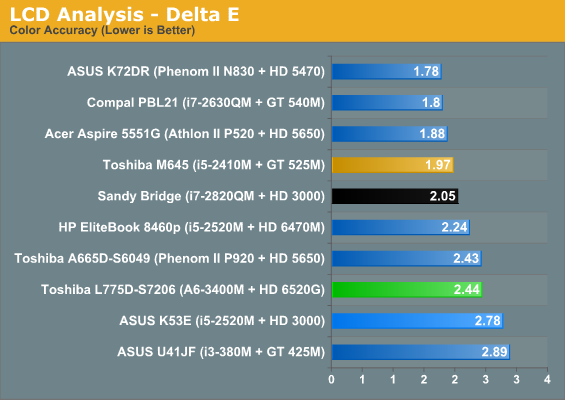
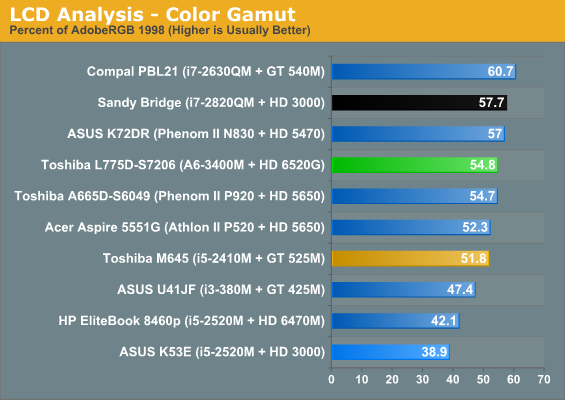
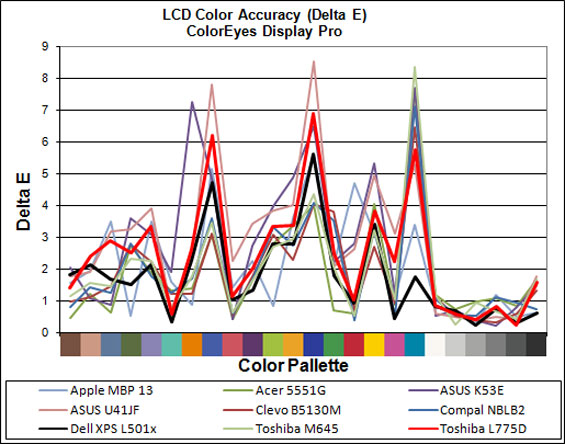
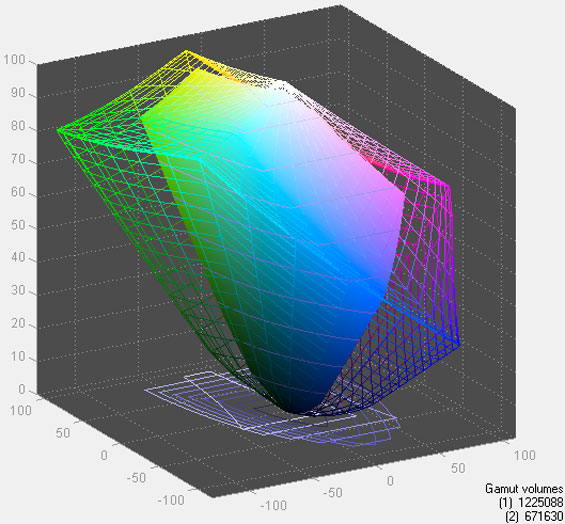
Poor black levels keep the Satellite's Samsung panel from achieving a decent contrast ratio, and while the color gamut is alright, accuracy is in the toilet. Overall the screen is bright enough, but we're most definitely in budget laptop territory.
Viewing angles don't fare much better. This is a TN panel through and through and while notebooks like the substantially more expensive Alienware M17x R3 prove TN panels don't have to suck, it's still frustrating to see technology this mediocre continuing to run wild.















74 Comments
View All Comments
medi01 - Friday, August 12, 2011 - link
Let me guess. It slows down your web surfing experience, right? I mean pathetic 100Mb LAN socket on a device which 90%+ of the users would never ever use and the rest will use it only because there is no wlan. Shameless...Dustin Sklavos - Friday, August 12, 2011 - link
The issue is that it's a checkbox feature that shows up on absolutely everything these days, and if you're sharing media over your network as people are doing more and more, it's going to make a difference. The omission is silly.nitrousoxide - Friday, August 12, 2011 - link
Yeah, without this review we are already aware how awful Llano's CPU is. That is a truth given how low the frequency is. I own an Acer AS5560G with A6-3400M and I've done several tests on overclocking and undervolting the Llano.The A6-3400M can be safely undervolted from 1.05V to 0.90V without failing LinX stress test. This results in 2W power reduction in HD video playback and internet browsing, 3.5W power reduction in 3D games and up to 8W reduction in stress test. Peak temperature also drops by 12 degrees.
If you want to trade some battery life for performance, just overclock it to 1.8GHz and it runs stable at 0.95V. Then you get a 30% faster processor without consuming more power than stock A6-3400M. In fact, in stress tests, the overclocked A6-3400M consumes 4W less than stock. What about overclocking at stock voltage? At 1.05V you can bump the frequency to 2.4GHz, but this results in overheating.
As far as I know virtually every Llano can be massively undervolted or overclocked. It appears to me that AMD is too conservative with Llano's voltage and clock speeds, perhaps due to the fact that Llano is released in a hurry. They could've get a much much faster Llano just with some more tweaks.
Novaguy - Friday, August 12, 2011 - link
There are a lot of people overclocking and undervolting their HP dv6zqe's into the 2.2 and up ghz range. Apparently the chips are unlocked.I have the dv6zqe and it is going well, except the 6750M (yeah, I did the crossfire) sometimes runs hot/noisy. I have not tried overclocking/undervolting but probably will sometime in the future (probably after it goes off warranty).
I think AMD could have tweaked voltages and clocks on the better chips so that there was model that had a 2.4 stock/2.8 turbo cpu with maybe a 550 or 600 speeds on the gpu portion - that could eliminate the need for a crossfire or perhaps improve the timing so that it is a bit more symmetric. An A8-3550MX or A8-3570MX, if you will.
The other issue - for those that got MX chips, HP is only using 1333 memory chips, when it looks like 1600 mhz is supported (for the MX llano's) and would give better graphics results. This toshiba looks like it doesn't have MX chips, so 1333 is probably the max memory speed. I wish laptop manufacturers had a 1600 option.
Roland00Address - Friday, August 12, 2011 - link
It is the newest version of k10stat, correct?Novaguy - Saturday, August 13, 2011 - link
Yes, it's one of the recent versions of k10stat. Maybe the last two versions, as I vaguely remember reading that a new version came out. There are a whole bunch of tables of volts/speeds on various forums using this program.I have not personally tried undervolting/overclocking as I have not installed anything that needs more performance. So far I am just doing browsing and playing early 2000's rpgs (diablo II) and the stock speeds are sufficient. But once I finish that I might move on to something that needs more fps....
R3MF - Friday, August 12, 2011 - link
"I'd've killed for a Llano-equipped notebook that could run something like Guild Wars on the battery with good performance. There is a market for this"True, 3D battery life is a standout for Llano, but I want to see a 35W A8 Llano sporting 400 shaders shoe-horned into a 12" chassis.
Now that would be made of WIN!
Anato - Friday, August 12, 2011 - link
At the price point i5-2520M is out of the league. I'd like to see i3-2310m in the chars. Tho results AMD-Intel would be the same, Intel wins CPU-tasks AMD Graphics.oceanrock - Thursday, August 25, 2011 - link
I can tell you that the i3-2310 w/o dGPU (ACER timelineX 5830T), was faster, but not as smooth (responsive and enjoyable) as an ACER Aspire AS5253-BZ849 equipped with an E350!The i3 was constantly shifting its speed and spent most of the time at ~800 mhz and 20%utilization, the E350 spent most of the time at 1.2/1.6 ghz with 50-80%utilization. it still lasted 4-8 hours and kept real cool the whole time. the i3 was a bit louder, jerky, not as cool, but lasted 8-12 hours. Also, it cost $100 more...
Go figure???
gc_ - Friday, August 12, 2011 - link
Anandtech, could you please find a way to label laptop comparison graphs with the relevant HD/SSD model or specs? In some benchmarks the HD or SSD is more relevant than the GPU, yet the graphs seem to give all the credit/blame to the CPU or GPU. These days the CPU is often fast enough for many office/school tasks and the storage system is the bottleneck.